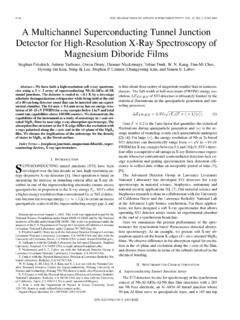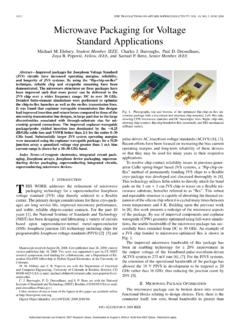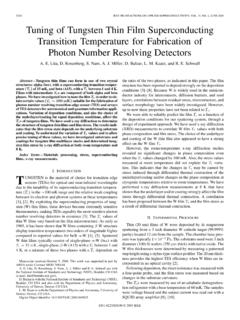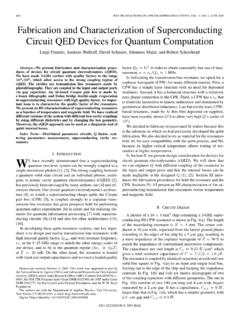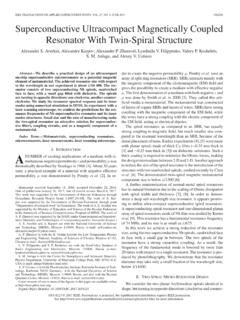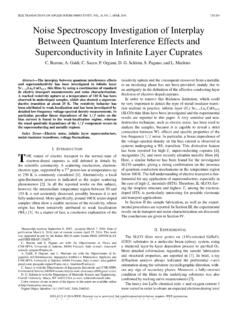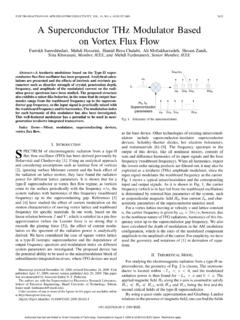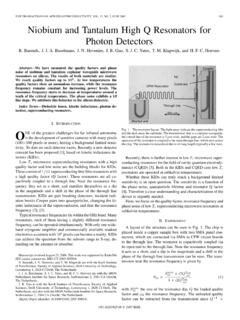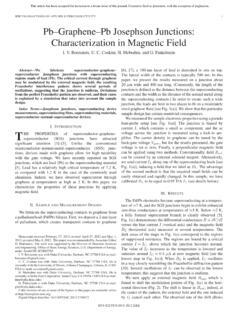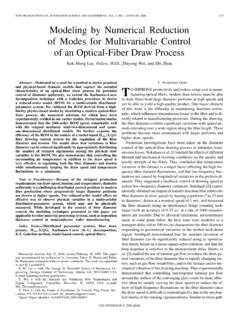Transcription of Effects of oxygen content on ybco josephson junction ...
1 ieee transactions ON applied SUPERCONDUCTIVITY, VOL. 9, No. 2, JUNE 1999 2993. Effects of oxygen content on ybco josephson junction Structures Jason P. Sydow, Michael Berninger and Robert A. Buhrman Cornell University, Ithaca NY. Brian H. Moeckly Conductus Inc. Sunnyvale CA. Abstract-The high degree of crystal stress and strain 111. CO-SNSJUNCTIONS. present at, and in the vicinity of, high angle grain boundary (GBJ), ramp edge COdoped SNS (CO-SNS),or Fig. 1 presents IV characteristics for a CO-SNS junction interface engineered junctions (IEJ) can lead to localized with a normal layer comprised of 30% CO doped ybco . and highly non-uniform regions of basal plane oxygen Previous work with CO- ybco thin films has demonstrated loss in YBa2Cu30,.6 ( ybco ). These oxygen inho- that ozone annealing can increase the T, of this material to mogeneities will, to a greater or lesser degree, affect or 75K [4].
2 Fig. 1 demonstrates that by substantially increasing cause the superconducting weak link behavior demon- the oxygen content and order of the N-layer and subsequently strated by these types of junctions. In order to examine increasing T,, ozone annealing has transformed the device the impact of the localized oxygen microhanostructure f?om a resistively shunted junction (RSJ) with substantial on the weak link behavior of these three junction tech- excess current at T=35K, to a flux flow type characteristic. nologies, we have utilized ozone anneals to provide a par- After ozone annealing, and at 35K, the device is SS'S, where tial pressure of atomic oxygen far in excess of that pro- S' is the CO- ybco with a T, close to 75K. duced by standard O2 anneals. Fig. 2 presents IV characteristics for one junction at a vari- ety of temperatures, following a series of annealing treat- I.
3 INTRODUCTION ments, each lasting Hr. Current and voltage have been scaled by I, and I,R, respectively. I, was determined by a 1. The enhanced partial pressure of atomic oxygen provided pV criterion while R, was taken from the asymptotic value at by ozone is used to achieve a greater level of oxygenation in P31,. Fig. 2 provides further evidence that the primary eEct stressed ybco systems, such as doped or crystalographically of ozone annealing is to increase the oxygen content well strained ybco , than that which is routinely obtained beyond that achieved by standard 0 2 anneals, and through standard -5 OOC, 1 atm. 0 2 , post fabrication anneals. substantially raise the temperature at which the device As we shall see below, by performing ozone anneals on vari- functions in the RSJ regime, up to 80K. Furthermore we note ous HTSC josephson junction structures, we are able to ob- that by scaling the data, and choosing temperatures which serve the more intrinsic nature of the weak link present in a yield a similar I,R, product, we obtain remarkably similar IV.
4 Particular device architecture without the added complication characteristics. This result indicates that the intrinsic junction of the oxygen disorder and loss which is often a secondary structure , the thickness of the N-layer and the relative importance and effect of the S-N interface, is not altered by - effect of the fabrication procedure. 11. OZONE ANNEALING. GBJ, CO-SNS, and IEJ devices were fabricated at Conduc- tus Inc. The fabrication procedure for each junction architec- ture is provided elsewhere [ 11-[3]. Current-voltage (IV) char- - '. - ~ ~ ~ I ~ I ~. Post 1st 500C O2. Post 500C Ozone II , *I *I ~ ~ ~ / ~ ~I ~ I ~50 J ~ ~. - 25 On I I ~ ~. acteristics were collected before and after various annealing 0. 'I. I). treatments including ozone annealing. During anneals, sam- ples were mounted with silver paste to a Haynes 214 alloy a A.]
5 Block which was heated by an enclosed halogen lamp. For O2 - 0 B. E. and Ar anneals, the chamber was pumped down to -Sx104. Torr, and backfilled to slightly over 1 atm. For 0 2 / 0 3 an- 5. I. neals, O2 was flowed through a commercial ozone generator i? creating an 0 2 / 0 3 mix with -2% 0 3 , by weight. The 0dO3 - -25 5. mixture then flowed through the annealing chamber at slightly greater than 1 atm. Upon cool-down, the flow was maintained until the sample was near room temperature and then removed from the chamber. """""'""'""'""'""'""""' -50. 0 Manuscript received Sept. 14, 1998. This research was supported in part Voltage (mVolts). by the Office of Naval Research and made use of the facilities of the Cornell MSC facilities supported by NSF under Award No. DMR-9632275. Fig. 1 IV characteristics at 35K for a CO-SNSjunction before and after ozone annealing.
6 1051-8223/99$10,00 0 1999 ieee . 2994. 3. 2 t - _t_ 35K, Post 1st 500C O2. 80K, Post 500C Ozone also note that the fust Hr., 500C 0 2 anneal is insufficient to return the junction to the as deposited state. Additional time at 500C in O2 is required to complete the oxygen loss necessary to regain the initial conditions. JUNCTIONS. IV. GRAINBOUNDARY.. c The typical effect of ozone annealing on the IV characteris- tic for a GBJ at (5 pm wide, -200 nm thick, misorien- tation angle -23") is demonstrated in Fig. 4. I, increased from mA to mA while R, decreased from to C2 for a net decrease in I,R, product ftom to mV. The general similarity of I,R, products in spite of the: more dramatic change in I, and R, is clarified in Fig. 5 which. portrays scaled IV characteristics for the same data. Again, E;. in the case for CO-SNS junctions, the scaled data agrees.
7 1 0 . 0 , , , , , , , , , , , , , , , , , , , , , , ,, ' , ,, , " ' , ". ' i /. " ' ~. " ' ~. - " ' ~. 0. ". Post 500 C Ozone Anneal ' ~. " ' ~. " ' i " '. Voltage (mVolts). Fig. 4 1V characteristics at for a GBJ before and after ozone an- nealing at 500C for Hours. 6. EB. A. Post Ist500C02. Post500 COzone 2l Post 3rd 500C O2. - - 4 - - - - - - - m- - - - Post 500 C O2 Anneal Post 500 C Ozone Anneal !- 4 2 - .+- 5 0 - 5. U. -2. -4. -6. 20 30 40 50 60 70 80 90. Temperature (K). Fig. 3 I,R, versus Temperature for three CO-SNS junctions following a Scaled IV characteristics at for the GBJ portrayed in Fig. 4. Fig. 5. series of O2 and ozone anneals. 2995. before and after ozone annealing. We attribute this to the fhct that the GBJ consists of at least two components; a relatively immutable barrier layer closely associated with the physical Post 5 OOC Ozone grain boundary which does not substantially change with ozone annealing, and regions of de-oxygenated ybco on Post 2nd 500C O2.
8 Either side of the grain boundary which impact I, and R,, but not I,R, and the intrinsic RSJ behavior of the device. An important difference between the CO-SNSand GBJ devices is that the operating temperature is not affected by ozone anneal- ing as demonstrated by Fig. 6 which portrays IcRn versus temperature after a series of anneals. This figure demonstrates that I,R, is relatively constant across the entire temperature - d - =. Post 2 SOC Argon 100 v Post300 CArgon ! range before and after ozone annealing. I,R, only begins to ,%b N Post325 CArgon I. decrease with the substantial amount of oxygen loss induced h]'. by the 250 and 300C Ar anneals. Following these Ar anneals the 1,'s have substantially decreased to 116 and 33 pA re- spectively. The consistency of the I,R, product across a broad ' ' ' """'. 10 " ' 1 ' 1 ' 1 " " ' 1 ' 1 ' " ' t l l ' l ' " ' , 1 1 1 1.
9 Range of values for J, is portrayed in Fig. 7. The scaling of 1,R, with J, in the lower J, region has been observed in pre- vious investigations, and has been attributed to a variety af mechanisms [ 11, [5-71. The newly observed plateau behavior for I,R, in the case of optimally and nearly optimally oxygen - ated devices can be explained by the limiting effect of the intrinsic barrier in the immediate vicinity of the grain bound- ary, which is not altered by ozone annealing. The eff'ect of ozone annealing is to increase the amount of completely oxy- genated ybco material adjacent to the grain boundary, and thus increase the effectivejunction area, which increases I, and decreases R, while holding I,R, constant. As de-oxygenation of the grain boundary continues with Ar anneals at higher temperatures, the volume of oxygen deficient ybco spreads outwardly in a non-uniform manner from the grain boundary, eventually thickening the barrier, and decreasing the 1,R.]]
10 Product. It is important to note that 1-10 pm wide GBJ's have shown similar plateau behavior when oxygenated by ozone annealing and electromigration. The independence of junction width on the plateau discounts explanations 1400 I , , I , , , I , , , I , , , I , , , 1000 . ;.., a e A. a 61. Post 1st 500C O2. Post SOOC Ozone Post 2nd 500C 0. Post 250C Argon Post 300C Argon 1. h 1. v 'i .. fl 600 A*. e w * .? ../. -3 ~ ~ ~ " ~ " " ~ " " ~ " " ~. 0 20 40 60 80 100 -3 -2 -1 0 1 2 3. Temperature (K) Voltage / IcRn Fig. 6 I,R, versus temperature for a single GBJ following a series of Fig. 8 Scaled IV characteristics for an IEJ before and after ozone anneals. 02 and 0 2 / 0 3 anneal were conducted for Hr. while Argon annealing. anneals were lengthened to 3 Hr. 2996. fi-om to Ohms, and I,R, remains relatively con- stant, increasing from to mV.
